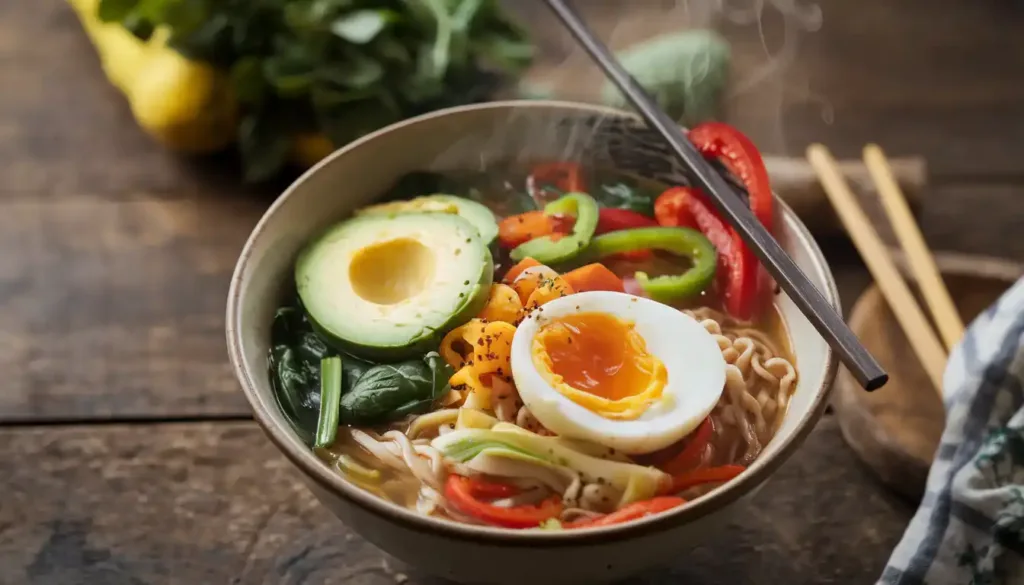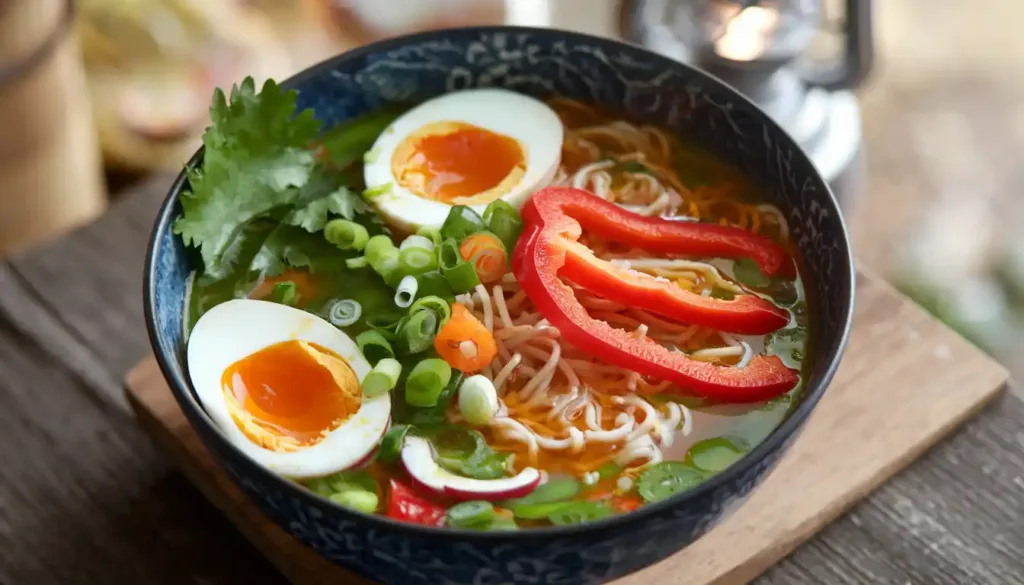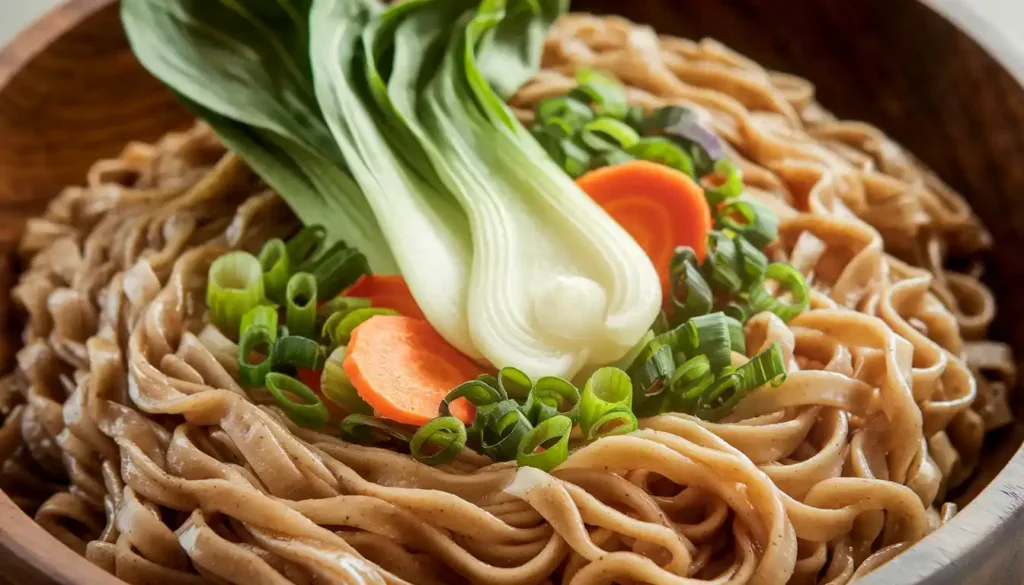How To Make Healthy Ramen Noodle Recipe
Table of Contents
Ever craved a warm, comforting bowl of ramen but felt terrible about its high sodium and lack of nutrients? You’re not alone. As a busy professional, I often turned to quick ramen for a meal. But I wanted to enjoy its flavors without harming my health.
So, I started looking for ways to make ramen both nutritious and tasty. This journey taught me how to make a healthy, delicious ramen noodle recipe.

In this guide, I’ll share my tips for making ramen healthier. You’ll learn to pick the right noodles, make a tasty broth, and add lots of veggies and lean proteins. This way, you can enjoy a healthier version of this favorite comfort food.
Key Takeaways
- Discover how to make a nutritious and delicious ramen noodle recipe at home.
- Learn about the benefits of choosing whole-grain or gluten-free ramen noodles.
- Explore ways to create a flavorful and low-sodium broth base for your ramen.
- Discover nutrient-dense vegetable toppings and lean protein sources to add to your ramen.
- Uncover simple and easy-to-follow ramen recipes that are both healthy and satisfying.
Introduction to Healthy Ramen Noodle Recipes
Traditional ramen noodles are often high in sodium, fat, and processed ingredients. This makes them less than ideal for a nutritious meal. But, by using healthy ramen noodle recipes, you can enjoy ramen’s comforting flavors while making it healthier.
Why Opt for Healthier Ramen Noodles?
Choosing nutritious ramen over the standard variety has many benefits. Whole grain ramen noodles contain complex carbs, fiber, and vitamins and minerals. They offer a healthier choice than refined noodles. Also, low-sodium ramen recipes help you keep your sodium intake in check, which is vital for good health.
Benefits of a Nutritious Ramen Dish
Creating a healthy ramen noodle recipe lets you enjoy a satisfying and nourishing meal. This meal offers several benefits:
- It’s packed with fresh veggies, lean proteins, and wholesome noodles, boosting your nutrient intake.
- It has fewer calories and sodium than traditional ramen.
- It keeps you full and gives you sustained energy thanks to its balanced nutrients.
- It’s good for your digestive health because of the fiber in the noodles and veggies.
By choosing healthy ramen noodle recipes, you can enjoy ramen’s comforting taste while supporting your health. As you try different recipes, you’ll find many nutritious and tasty ramen options.

Choosing the Right Noodles
Choosing the right noodles is key to making a healthier ramen dish. Whole grain and gluten-free ramen noodles are great options. They make your ramen healthier and tastier.
Whole Grain Ramen Noodle Options
Whole grain ramen noodles are a great choice for a healthier base. They’re made from whole wheat flour. This adds fiber, complex carbs, and more nutrients than regular noodles.
Adding whole grain noodles to your ramen gives it a nutty flavor and a chewy texture. It makes your dish more satisfying.
Gluten-Free Ramen Alternatives
If you’re gluten-free or sensitive, there are many tasty alternatives. Brown rice, buckwheat, and mung bean noodles are all gluten-free. They offer different flavors and textures.
These noodles are not only good for your diet but also add variety to your ramen. They make your homemade ramen special and delicious.
| Noodle Type | Nutritional Benefits | Flavor and Texture |
|---|---|---|
| Whole Grain Ramen Noodles | – Fiber-rich – Complex carbohydrates – Nutrients from whole grains | – Nutty, earthy flavor – Chewy, satisfying texture |
| Gluten-Free Ramen Alternatives | – Suitable for gluten-free diets – Variety of grain sources (brown rice, buckwheat, mung bean) | – Unique flavors (nutty, earthy, delicate) – Wide range of textures (chewy, delicate, firm) |
Exploring whole grain and gluten-free noodles can make your homemade ramen healthier and tastier. It meets the needs of many diets and preferences.

Nutritious Broth Bases
The broth is key to a great ramen dish. It’s what makes the meal tasty and healthy. Choosing a low-sodium broth is important for a healthy ramen recipe. Nutrient-rich broth bases make your ramen better for you.
Low-sodium ingredients are crucial for a healthy ramen broth. Traditional broths can have too much sodium. Look for broth bases that are low in sodium but still flavorful.
Bone broth is a great choice for ramen. It’s low in sodium and packed with nutrients like collagen and amino acids. Vegetable broths are also good, adding vitamins and flavors from fresh produce.
| Broth Type | Sodium Content | Nutritional Benefits |
|---|---|---|
| Bone Broth | Low | Collagen, gelatin, amino acids |
| Vegetable Broth | Low | Vitamins, minerals, fiber |
| Low-Sodium Chicken or Beef Broth | Moderate | Protein, nutrients from meat |
Using these healthy broth bases in your ramen makes it both tasty and good for you. Focus on low-sodium options and learn about the health benefits of different broths.
“A well-crafted broth is the foundation of a delicious and nourishing ramen dish.”
Vegetable-Packed Ramen Toppings
Adding a variety of vegetables to your ramen can make it both healthy and tasty. Different veggies bring colors, textures, and important nutrients. These nutrients help fuel your body.
Nutrient-Dense Vegetable Choices
For vegetable-packed ramen, you have many choices. Leafy greens like spinach, kale, or bok choy add fiber and vitamins. Carrots, bell peppers, and bean sprouts offer crunch and vitamins too.
- Leafy greens: Spinach, kale, bok choy
- Crunchy vegetables: Carrots, bell peppers, bean sprouts
- Mushrooms: Shiitake, oyster, or cremini for added umami
- Scallions or green onions for a fresh, aromatic touch
Choosing a mix of nutrient-dense vegetable choices makes your ramen balanced and fulfilling. It’s good for your body and tastes great.
“Eating a rainbow of vegetables is the key to a healthy and vibrant ramen dish.”
Lean Protein Sources for Ramen
Adding lean protein to your ramen can make it a nutritious and satisfying meal. It turns your ramen into a balanced dish that keeps you full and energized. Let’s look at some top lean protein options for your high-protein ramen recipe.
Chicken is a popular choice. Grilled or baked chicken breasts are a lean protein source. They can be sliced or shredded and added to your ramen. Lean cuts of beef, like sirloin or flank steak, also work well. They add a hearty texture and more protein.
- Firm, low-fat tofu is a great vegetarian protein source. It can be cubed or crumbled and added to your ramen.
- Shrimp or other seafood, like scallops or thinly sliced fish, add protein and flavor to your ramen.
- For a plant-based boost, try adding edamame, tempeh, or cooked lentils or chickpeas to your high-protein ramen.
Choose lean, minimally processed proteins to enhance your ramen’s nutrition and taste. By balancing carbs, veggies, and quality protein, you get a high-protein ramen that’s both tasty and healthy.
Flavorful and Low-Sodium Seasoning Options
Creating a tasty and healthy ramen dish starts with the seasoning. Use low-sodium herbs and spices to add flavor to your low-sodium ramen. This way, you can enjoy bold tastes without losing the health benefits. Let’s look at the top herbs and spices for ramen to make your ramen stand out.
Herbs and Spices for Ramen
Ramen is a great chance to show off your cooking skills. Instead of using salty seasoning packets, try these healthier options:
- Fresh ginger: Adds a warm, slightly spicy kick to the broth.
- Garlic: Enhances the savory umami notes in the ramen.
- Scallions: Lend a delicate onion flavor and vibrant green color.
- Cilantro: Provides a fresh, herbal note that complements the noodles.
- Sesame seeds: Impart a nutty, toasted flavor when sprinkled on top.
- Crushed red pepper flakes: For a touch of heat and a pop of color.
Try these herbs and spices for ramen to make your ramen unique and full of flavor. This way, you can enjoy a delicious meal without too much sodium.
Creating a balanced and nutritious ramen is all about finding the right seasonings. With a bit of creativity and a focus on healthy ingredients, you can turn a simple ramen into a masterpiece.
Healthy Ramen Noodle Recipe
Ramen noodles are a favorite comfort food, but they can be high in sodium. You can make a healthy ramen noodle recipe that’s both delicious and nutritious. Let’s explore a recipe that shows how ramen noodle recipes can be a healthy and satisfying meal.
First, choose whole-grain or gluten-free ramen noodles. These options are healthier than regular noodles. They add more fiber and nutrients to your meal.
Next, we’ll make the broth. Instead of using high-sodium broths, we’ll make one from scratch. Simmer vegetables like onions, carrots, and mushrooms with herbs and spices. This way, you’ll get a broth that’s delicious and full of nutrients.
Now, let’s talk about the toppings. Add a variety of nutrient-dense vegetables like spinach, bell peppers, and snow peas. These veggies increase the vitamins, minerals, and fiber in your ramen. You can also add lean protein like grilled chicken or tofu for a balanced meal.
Season your ramen with a flavorful yet low-sodium mix of herbs and spices. Try using garlic, ginger, and scallions to enhance the taste of your healthy ramen noodle recipe.
By following these steps, you can make a delicious and nutritious ramen noodle dish. Enjoy the comfort of ramen while nourishing your body and soul. Explore the world of healthy ramen noodle recipes for a wholesome meal anytime.
Simple and Delicious Ramen Recipes
Make your ramen experience better with these quick and easy recipes. Whether you want a simple yet tasty meal or something new, these recipes will hit the spot. They’re perfect for anyone looking for simple and delicious ramen.
Quick and Easy Ramen Bowls
Make a tasty ramen bowl in no time with these recipes:
- Miso Ramen Bowls: Mix miso broth, cooked noodles, sautéed veggies, and a soft-boiled egg for a tasty meal.
- Spicy Chicken Ramen: Add a spicy broth, shredded chicken, fresh herbs, and sriracha for a kick.
- Veggie-Packed Ramen: Fill your bowl with colorful veggies like bell peppers, carrots, and bok choy.
- Pork Belly Ramen: Enjoy tender pork belly, classic noodles, and a rich broth.
These recipes are quick to make, so you can enjoy a delicious ramen dish any night.
“Ramen is not just a dish, it’s an experience. These simple and delicious recipes will transport you to a world of bold flavors and comforting noodles.”
Try different proteins, veggies, and broths to make your own ramen creations. The possibilities are endless for making simple yet delicious ramen recipes.
| Recipe | Prep Time | Cook Time | Total Time |
|---|---|---|---|
| Miso Ramen Bowls | 10 minutes | 20 minutes | 30 minutes |
| Spicy Chicken Ramen | 15 minutes | 25 minutes | 40 minutes |
| Veggie-Packed Ramen | 12 minutes | 18 minutes | 30 minutes |
| Pork Belly Ramen | 20 minutes | 30 minutes | 50 minutes |
Vegan and Vegetarian Ramen Variations
In the world of vegan ramen options, the possibilities are endless. You can find a meat-free and dairy-free alternative or explore plant-based flavors. There’s a ramen variation for everyone.
The miso-based broth is a favorite vegan ramen choice. It’s made with fermented soybean paste, vegetable stock, and spices. This broth is the base for a nourishing vegan ramen bowl.
Add colorful and crunchy veggies like sautéed mushrooms, julienned carrots, and tender bok choy. They make the dish both nutritious and beautiful.
For a heartier vegan ramen, add protein-rich ingredients like tofu, tempeh, or seitan. These can be marinated, baked, or simmered. They add a delightful texture to the dish.
Try different toppings to make your vegan ramen even better. Add chopped scallions, crispy tofu crumbles, or a drizzle of chili oil. Top it with cilantro or sesame seeds for a vibrant look and taste.
Whether you follow a vegan diet or not, vegan ramen options are a great choice. They offer a delicious and nourishing ramen experience. Explore the many flavors of plant-based ramen.
Low-Calorie Ramen for Weight Management
Starting a healthier lifestyle doesn’t mean you must give up your favorite foods, like ramen. With a few easy changes, you can make a tasty low-calorie ramen that helps with weight loss.
Portion Control and Calorie-Conscious Tips
To enjoy ramen while keeping an eye on your weight, focus on portion control and making smart choices. Here are some tips for a fulfilling, yet low-calorie ramen meal:
- Choose a smaller ramen noodle serving, like half or three-quarters.
- Add lots of veggies like mushrooms, spinach, and carrots to make your bowl bigger without too many calories.
- Go for lean proteins like grilled chicken or shrimp to add flavor and substance without too many calories.
- Use a low-sodium broth to cut down on sodium.
- Try herbs and spices to make your ramen taste great without using high-calorie sauces or seasonings.
By following these tips, you can enjoy the comforting taste of low-calorie ramen while helping with weight loss. Remember, it’s all about balance and moderation for a healthy diet.
“The secret to enjoying ramen while watching your weight is all about making smart, calorie-conscious choices without sacrificing flavor.”
With a bit of creativity and smart choices, you can enjoy ramen’s delicious taste while working on your weight-loss goals. Try different veggies and proteins to find your favorite low-calorie ramen recipe.
Tips for Meal Prepping Healthy Ramen
Preparing healthy ramen noodle dishes in advance can change your diet for the better. Meal prepping your ramen means you always have a nutritious meal ready, even when you’re busy. Start with whole grain or gluten-free noodles for more nutrition.
Make a flavorful broth with low-sodium ingredients. Add lots of fresh veggies for fiber, vitamins, and minerals.
Meal prepping ramen helps you control how much you eat. Measure out the right amount of noodles and protein for balanced meals. Store your prepped ramen parts separately for easy reheating.
With these tips, making how to make ramen noodles and is ramen noodle recipes healthy becomes easy. Enjoy your homemade, nutritious ramen bowls all week.
FAQ
What are the benefits of choosing healthier ramen noodle recipes?
Choosing healthier ramen noodle recipes has many benefits. Traditional ramen can be high in sodium and calories. But, making healthier choices lets you enjoy a more wholesome meal.
Healthier ramen often uses whole grain noodles and low-sodium broth. It also includes nutrient-dense toppings. This makes it a better choice for your health and well-being.
What are some whole grain ramen noodle options?
Whole grain ramen noodles are a great choice for a healthy meal. Look for noodles made with whole wheat flour or brown rice. These noodles are higher in fiber and nutrients than refined noodles.
What are some gluten-free ramen alternatives?
If you need gluten-free ramen, there are many options. You can find noodles made from buckwheat, mung bean, or konjac root. These alternatives let people with dietary restrictions enjoy a healthy ramen dish.
How can I create a nutritious broth base for my ramen?
A flavorful and nutritious broth is key for a healthy ramen. Use low-sodium broths or make your own from vegetables, herbs, and spices. This will make your ramen taste great and be healthier.
What are some nutrient-dense vegetable choices for ramen?
Adding nutrient-dense vegetables to your ramen makes it a nourishing meal. Good choices include spinach, kale, bell peppers, mushrooms, carrots, and bean sprouts. These vegetables add vitamins, minerals, and fiber.
What are some lean protein sources that can be added to ramen?
Adding lean proteins like grilled chicken or shrimp, tofu, hard-boiled eggs, or edamame makes ramen high in protein. These ingredients keep you full and add nutrition to your meal.
How can I add flavor to my healthy ramen without using too much sodium?
Use low-sodium or no-sodium ingredients to season your ramen. Try ginger, garlic, scallions, sesame seeds, and chili peppers for flavor. Low-sodium soy sauce, rice vinegar, or citrus juices also add depth without salt.
Can I make a delicious ramen noodle recipe that is also healthy?
Yes! With the right ingredients, you can make a healthy and tasty ramen. Choose whole grain or gluten-free noodles, make a low-sodium broth, and add vegetables and lean proteins. This way, you can enjoy a satisfying and healthy ramen dish.
What are some simple and delicious ramen recipes I can try?
There are many simple and tasty ramen recipes to try. From quick bowls to elaborate dishes, the options are endless. Experiment with different noodles, broths, and toppings to find your favorite.
Are there vegan or vegetarian ramen options available?
Yes, there are many vegan and vegetarian ramen options. Use plant-based proteins like tofu, tempeh, or seitan, and add lots of vegetables. This way, you can enjoy delicious and satisfying ramen that fits your dietary preferences.
Can I make low-calorie ramen recipes for weight management?
Absolutely! Ramen can be part of a healthy diet for weight management. Choose low-calorie noodles, a light broth, and portion your ingredients carefully. This way, you can enjoy ramen while supporting your weight goals.
How can I meal prep healthy ramen noodle recipes?
Meal prepping healthy ramen recipes is a great way to stay healthy. Prepare the noodles, broth, and toppings in advance. Then, assemble your ramen bowls when you’re ready to eat. This makes it easy to include healthy ramen in your meal plan.







